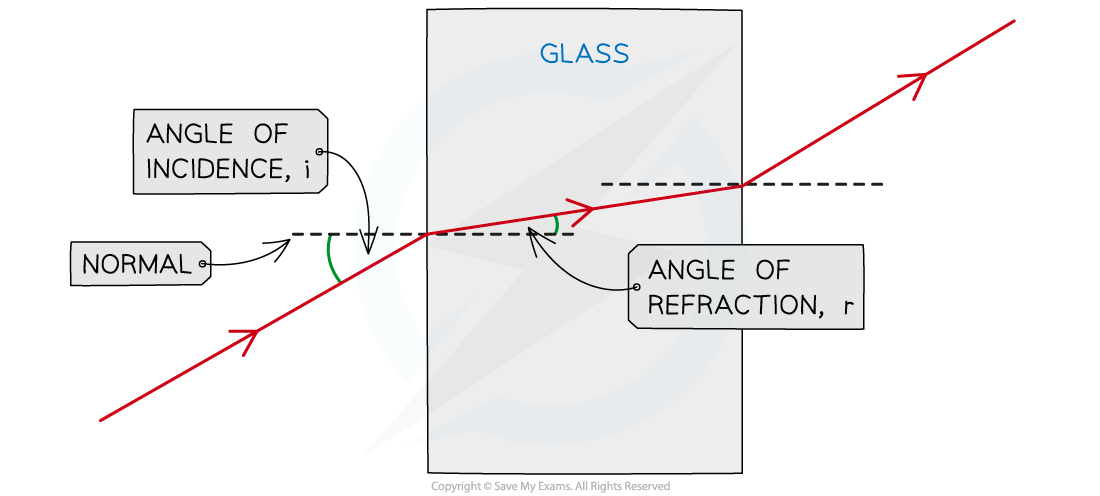Convex & Concave Lenses (OCR GCSE Physics A (Gateway)) : Revision Note
Convex & Concave Lenses
Refraction Ray Diagrams
Refraction occurs when light passes a boundary between two different transparent media
At the boundary, the rays of light undergo a change in direction
The direction is taken as the angle from a hypothetical line called the normal
This line is perpendicular to the surface of the boundaries and is usually represented by a straight dashed or dotted line
The change in direction depends on which media the light rays pass between:
From less dense to more dense (e.g air to glass), light bends towards the normal
From more dense to less dense (e.g. glass to air), light bends away from the normal
When passing along the normal (perpendicular) the light does not bend at all

How to construct a ray diagram showing the refraction of light as it passes through a rectangular block
The change in direction occurs due to the change in speed when travelling in different substances
When light passes into a denser substance the rays will slow down, hence they bend towards the normal
The only properties that change during refraction are speed and wavelength – the frequency of waves does not change
Different frequencies account for different colours of light (red has a low frequency, whilst blue has a high frequency)
When light refracts, it does not change colour (think of a pencil in a glass of water), therefore, the frequency does not change
Convex & Concave Lenses
A lens is a piece of equipment that forms an image by refracting light
There are two types of lens:
Convex
Concave
Convex Lenses
In a convex lens, parallel rays of light are brought to a focus
This point is called the principal focus
This lens is sometimes referred to as a converging lens
The distance from the lens to the principal focus is called the focal length
This depends on how curved the lens is
The more curved the lens, the shorter the focal length
Convex lenses are commonly used in glasses to correct vision
The lens act with the eye to make sure the rays are directed to a focal point behind the retina
When the glasses are not there, the rays do not converge properly at a principal focus so the person cannot seen an image very well

The focal length is the distance from the lens to the principal focus
Concave Lenses
In a concave lens, parallel rays of light are made to diverge (spread out) from a point
This lens is sometimes referred to as a diverging lens
The principal focus is now the point from which the rays appear to diverge from
Concave lenses are commonly used in:
Binoculars
Telescopes
Flashlights
Cameras
They primarily magnify an image

Parallel rays from a concave lens appear to come from the principal focus
Representing Lenses
In diagrams, the following symbols are often used to represent each type of lens:

Concave and convex symbols
Worked Example
The diagram below shows two parallel rays of light entering and passing through prism A and prism C.

Draw a third parallel ray entering and passing through prism B.
Answer:
Step 1: Draw a parallel ray on the left

Step 2: Draw the refracted ray at the first surface

As the ray enters the block it bends towards the normal since it is going into a denser material
In this case, the angle of refraction is smaller than the angle of incidence
Step 3: Draw the refracted ray at the second surface

As the ray leaves the block it bends away from the normal
In this case, the angle of refraction is larger than the angle of incidence
Examiner Tips and Tricks
Make sure you remember the symbol for each type of lens, as you will be expected to draw these for ray diagrams in your exam!
To remember which lens is converging or diverging, think of the following: Convex lens = Converging

You've read 0 of your 5 free revision notes this week
Sign up now. It’s free!
Did this page help you?
